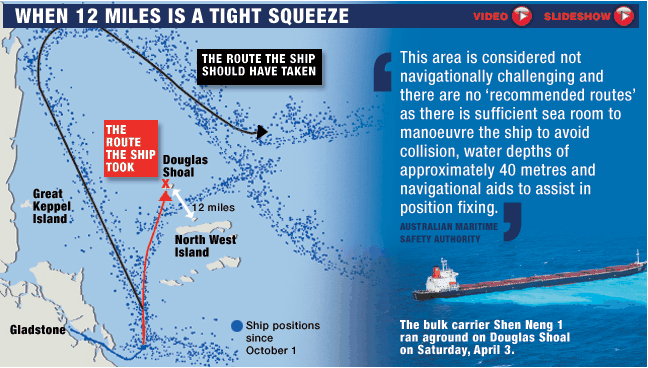Response Concludes for Oil Sheen Off Huntington Beach
A Unified Command on Monday concluded its response to an oil sheen spotted off the coast of Huntington Beach, California. Cleanup crews managed to recover approximately 85 gallons of product...
By KEITH BRADSHER
April 7, 2010, New York Times
HONG KONG — A Chinese coal freighter aground on the Great Barrier Reef has at least one punctured fuel tank, prompting a delicate effort to transfer oil within the ship to tanks that are still intact, Australian officials announced on Wednesday.
Very little oil has leaked yet because sea water has surged through the underwater puncture and the oil has floated up on the water inside at least one tank, officials said. Two tugboats are trying to stabilize the vessel, the Shen Neng 1, as it grinds up and down on a shoal in ocean swells and as salvage experts transfer the fuel between tanks.
“This is actually a delicate operation, and we won’t be rushing it,” said Patrick Quirk, the general manager for maritime safety for Queensland, the Australian state where the vessel ran aground. He added that a specialized salvage vessel would start trying to unload fuel from the vessel on Thursday or Friday.
The vessel went aground with 1,075 tons of thick engine fuel. Officials declined to estimate how much was in danger of leaking.
Anger about the grounding of the vessel is still rising in Australia, with Prime Minister Kevin Rudd offering some blunt language (see video below). On Tuesday, he flew over the stricken vessel, which had strayed more than seven miles outside the authorized shipping channel, and promised a full investigation to identify and punish those responsible.
The illustration below shows the route the vessel took, a ‘short cut’ through a 12 mile wide passage between North West Island and Douglas Shoal


A release from the Australian Maritime Safety Authority (AMSA) revealed that the vessel’s sailing plans showed it had always intended to travel through the ‘short cut’ where it ran aground, yet exactly how the vessel ended up stuck on the reef still remains a mystery as there is “sufficient sea room to maneuver”.
The Shen Neng 1 lodged a sailing plan through AMSA’s Rescue Coordination Centre – Australia prior to departing from Gladstone. The ship indicated that it would be following a route traversed by ships sailing from and sailing to the port of Gladstone and within the designated shipping area.
The planned departure route took the ship north from Gladstone until an alteration of course that would take the ship through a 12 mile wide passage between North West Island and Douglas Shoal, then into the open sea to the east via the Capricorn Channel. While the sailing plan provided an indication of the intended passage of the ship, the ship has deviated from its sailing plan, entered a prohibited area and run aground on Douglas Shoal.
This area is considered not navigationally challenging and there are no ‘recommended routes’ as there is sufficient sea room to maneuver the ship to avoid collision, water depths of approximately 40 meters and navigational aids to assist in position fixing.
As seen in the below map released by AMSA, while many ships take the safer, more northern route before heading out to the open ocean, the 12 mile-wide passage between North West Island and Douglas Shoal is also frequently used.


Join the gCaptain Club for curated content, insider opinions, and vibrant community discussions.


Join the 105,887 members that receive our newsletter.
Have a news tip? Let us know.
Access exclusive insights, engage in vibrant discussions, and gain perspectives from our CEO.
Sign Up




Maritime and offshore news trusted by our 105,887 members delivered daily straight to your inbox.



Essential news coupled with the finest maritime content sourced from across the globe.
Sign Up